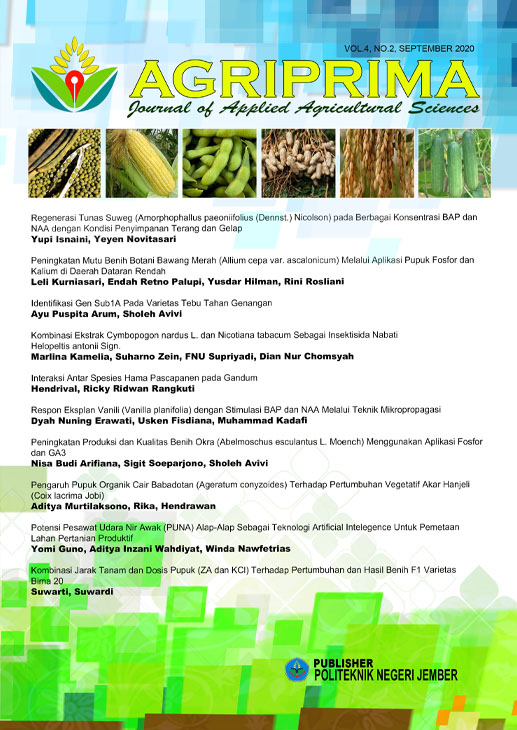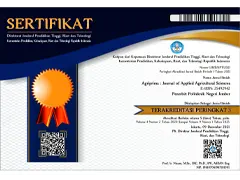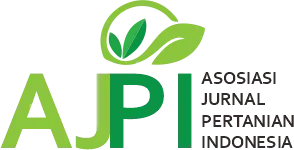Kombinasi Jarak Tanam dan Dosis Pupuk (ZA dan KCl) Terhadap Pertumbuhan dan Hasil Benih F1 Varietas Bima 20
DOI:
10.25047/agriprima.v4i2.369Downloads
Abstract
Penggunaan dosis pupuk yang tepat dengan pengaturan jarak tanam legowo merupakan faktor yang diharapkan dapat meningkatkan pertumbuhan tanaman dan produktivitas benih jagung hibrida. Tujuan dari penelitian ini adalah untuk menguji model jarak tanam jajar legowo ((100 cm - 50 cm) x 20 cm) dibandingkan dengan model jarak tanam normal (75 cm x 20 cm) dengan kombinasi berbagai dosis pupuk terhadap tingkat produktivitas benih jagung hibrida Bima 20. Percobaan dilaksanakan di Kebun Percobaan Balitsereal Maros, pada bulan Mei sampai dengan Agustus 2017. Percobaan dilakukan menggunakan Rancangan petak tersarang (nested randomized block design). Empat perlakuan pemupukan yaitu A : 350 kg/ha Urea + 50 kg/ha KCl; B: 350 kg/ha Urea + 100 kg/ha KCl; C : 350 kg/ha Urea + 50 kg/ha ZA; D ; 350 kg/ha Urea + 100 kg/ha ZA diulang tiga kali pada dua perlakuan jarak tanam yaitu jarak tanam konvensional 70 cm x 20 cm dan jarak tanam jajar legowo (100 cm- 50 cm) x 20 cm. Pengamatan pertumbuhan dan hasil panen dilakukan terhadap tanaman betina. Interaksi antara perlakuan menunjukkan berbeda nyata pada lebar daun. Hasil panen tertinggi pada faktor tunggal pupuk diperoleh pada kombinasi pupuk 350 kg/ha Urea + 50 kg/ha Za (10.62 ton/ha). Model jarak tanam jajar legowo secara mandiri menunjukkan hasil 9.66 t/ha lebih tinggi dibandingkan jarak tanam 75 cm x 20 cm. Koefisien korelasi Pearson dengan hasil biji tertinggi diperoleh pada peubah panjang tongkol dan tinggi tanaman (r=0.40).
Keywords:
Dosis pupuk, Jarak tanam, Pertumbuhan, ProduktivitasReferences
Apriliana, M. and M. Mustadjab. 2016. Analisis Faktor-Faktor yang Mempengaruhi Pengambilan Keputusan Petani Dalam Menggunakan Benih Hibrida Pada Usahatani Jagung (Studi Kasus di Desa Patokpicis, Kecamatan Wajak, Kabupaten Malang). HABITAT, 27(1). pp.7–13.
Arief, R., F. Koes, and A. Nur. 2013. Pengelolaan Benih Sorgum. In: Sumarno, D.S. Damardjati, M. Syam and Hermanto, (eds.) Sorgum (Inovasi Teknologi dan Pengembangan). Jakarta (ID): IAARD Press; Badan Penelitian dan Pengembangan Pertanian, pp.153-.
BMKG. 2018. Analisis Kondisi Meteorologi Pada Saat Banjir Tanggal 14 Mei 2018 di Kabupaten Sidrap Sulawesi Selatan [Online].
Efendi, R. and M. Azrai. 2010. Tanggap Genotipe Jagung terhadap Cekaman Kekeringan: Peranan Akar. Jurnal Penelitian Pertanian Tanaman Pangan, 29(1). pp.1–10.
Erawati, B.T.R. and A. Hipi. 2016. Pengaruh Jarak Tanam Terhadap Pertumbuhan dan Hasil Beberapa Varietas Jagung Hibrida di Kawasan Pengembangan Jagung Kabupaten Sumbawa. In Proceedings: Prosiding Seminar Nasional Inovasi Teknologi Pertanian Banjarbaru, 2016. Banjarbaru: Balai Pengkajian Teknologi Pertanian Nusa Tenggara Barat, pp.608–616.
Erungan, R.H., D.S. Runtunuwu, and J.E.X. Rogi. 2012. Produksi Jagung Manado Kuning Pada Jarak Tanam dan Dosis Pupuk Nitrogen Berbeda. EUGENIA, 18(3). pp.230–237.
Ikhwani, I. 2014. Dosis Pupuk dan Jarak Tanam Optimal Varietas Unggul Baru Padi. Jurnal Penelitian Pertanian Tanaman Pangan, 33(3). p.188.
Irwan, A.W., A. Wahyudin, R. Susilawati, and T. Nurmala. 2005. Interaksi Jarak Tanam dan Jenis Pupuk Kandang Terhadap Komponen Hasil dan Kadar Tepung Sorghum (Sorghum bicolor [ Linn .] Moench) pada Inseptisol di Jatinangor MH 2004. Jurnal Kultivasi, 4(2). pp.128–136.
Kementrian Pertanian. 2016. Outlook Komoditas Pertanian Tanaman Pangan “Jagung.” Jakarta: Pusat Data dan Sistem Informasi Pertanian, Kementerian Pertanian.
Koes, F. and Rahmawati. 2009. Pengaruh Lama Penyimpanan Terhadap Mutu Benih dan Produktivitas Jagung. In Proceedings: Prosiding Seminar Nasional Serealia, 2009. Maros, Sulawesi Selatan: Balai Penelitian Tanaman Serealia (Balitsereal), pp.283–289.
Kushartanti, E., D. Prasetianti, and S.C.B. Setyaningrum. 2019. Persepsi dan preferensi petani terhadap produktivitas jagung hibrida balitbangtan di Kabupaten Kendal. In Proceedings: Prosiding Temu Teknis Jabatan Fungsional Non Peneliti, 2019. Bogor: Pusat Perpustakaan dan Penyebaran Teknologi Pertanian, Kementrian Pertanian, pp.603–610.
Moser, S.B., B. Feil, S. Jampatong, and P. Stamp. 2006. Effects of pre-anthesis drought, nitrogen fertilizer rate, and variety on grain yield, yield components, and harvest index of tropical maize. Agricultural Water Management, 81(1–2). pp.41–58.
Pratama, E.Y., R. Hasputri, and R.T. Setiyono. 2019. Uji Daya Hasil Pada Beberapa Calon Varietas Jagung Hibrida di PT Mulya Agro Sarana. Jurnal Pertanian Presisi (Journal of Precision Agriculture), 3(2). pp.120–128.
Rahmansyah, B. and Sudiarso. 2018. Pengaruh Teknik Jajar Legowo dan Berbagai Jarak Tanam Pada Pertumbuhan dan Hasil Tanaman Jagung Bisi 16 (Zea mays identata). Jurnal Produksi Tanaman, 6(6). pp.1012–1019.
Rahmawati and S. Saenong. 2010. Mutu Fisiologis Benih pada Beberapa Varietas Jagung Selama Periode Simpan. In Proceedings: Prosiding Pekan Serealia Nasional, 2010. Maros, Sulawesi Selatan: Balai Penelitian Tanaman Serealia (Balitsereal), pp.478–485.
Sa’diyah, N., C.R. Siagian, and M. Barmawi. 2017. Korelasi dan Analisis Lintas Karakter Agronomi Kedelai (Glycine max [L.] Merrill) Keturunan Persilangan Wilis X MLG 2521. Jurnal Penelitian Pertanian Terapan, 16(1). pp.45–53.
Saputra, T.E., M. Barmawi, E. Ermawati, and N. Sa`diyah. 2017. Korelasi dan Analisis Lintas Komponen Komponen Hasil Kedelai Famili F6 Hasil Persilangan Wilis X B3570. Jurnal Penelitian Pertanian Terapan, 16(1). pp.54–60.
Sayo, S., K.O. David, J.A. Omolayo, M. Silvestro, S.F. Lawrence, O.O. Ayoola, and O.O. Adebiyi. 2017. Correlation and Path Coefficient Analysis of Top-Cross and Three-Way Cross Hybrid Maize Populations. African Journal of Agricultural Research, 12(10). pp.780–789.
Sesay, S., D.K. Ojo, O.J. Ariyo, and S. Meseka. 2016. Genetic Variability, Heritability and Genetic Advance Studies in Top-Cross and Three-Way Cross Maize (Zea Mays L) Hybrids. Maydica, 61(2). pp.1–7.
Sirappa, M.P. and N. Razak. 2010. Peningkatan Produktivitas Jagung Melalui Pemberian Pupuk N, P, K dan pupuk Kandang pada Lahan Kering di Maluku. In Proceedings: Prosiding Pekan Serealia Nasional, 2010. Maros, Sulawesi Selatan: Balai Penelitian Tanaman Serealia (Balitsereal), pp.1–10.
Srihartanto, E., S.W. Budiarti, and Suwarti. 2013. Penerapan Sistem Jajar Legowo Jagung Hibrida Untuk Peningkatan Produktivitas di lahan Inceptisol Gunung Kidul. In Proceedings: Seminar Nasional Serealia, 2013. Maros, Sulawesi Selatan: Balai Penelitian Tanaman Serealia (Balitsereal), pp.98–103.
Sutoro. 2012. Kajian Penyediaan Varietas Jagung untuk Lahan Suboptimal. Iptek Tanaman Pangan, 7(2). pp.108–115.
Syafruddin, S. 2016. Manajemen Pemupukan Nitrogen Pada Tanaman Jagung. Jurnal Penelitian Dan Pengembangan Pertanian, 34(3). p.105.
Syafrudin, N., M. Azrai, and N. Suwarti. 2016. Seleksi Genotipe Jagung Hibrida Toleran N Rendah. Buletin Plasma Nutfah, 19(2). p.73.
Syuryawati, S. and F. Faesal. 2016. Kelayakan Finansial Penerapan Teknologi Budi Daya Jagung pada Lahan Sawah Tadah Hujan. Jurnal Penelitian Pertanian Tanaman Pangan, 35(1). p.71.
License
Copyright (c) 2020 FNU Suwarti, FNU Suwardi

This work is licensed under a Creative Commons Attribution-ShareAlike 4.0 International License.
You are free to:
- Share — copy and redistribute the material in any medium or format.
- Adapt — remix, transform, and build upon the material for any purpose, even commercially.
Under the following terms:
- Attribution — You must give appropriate credit, provide a link to the license, and indicate if changes were made. You may do so in any reasonable manner, but not in any way that suggests the licensor endorses you or your use.
- ShareAlike — If you remix, transform, or build upon the material, you must distribute your contributions under the same license as the original.
- No additional restrictions — You may not apply legal terms or technological measures that legally restrict others from doing anything the license permits.









